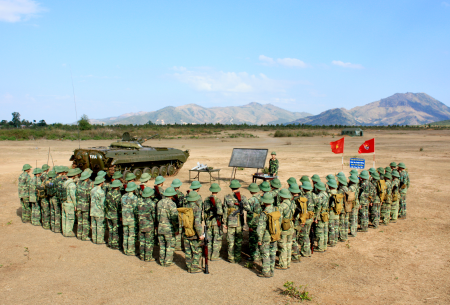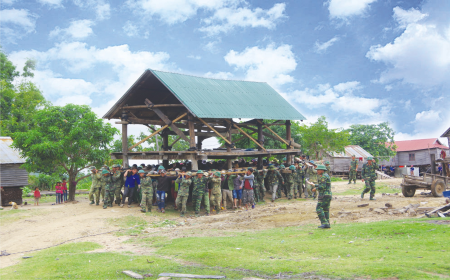70 years ago, in order to meet the urgent requirements of the resistance war against the French colonialists on the Northern battlefields, the Delta Division (the present-day Division 320 - hereafter the Division) was established. Under the motto: “Both fighting and constructing, dispatching troops to the battle as many as possible, using any weapon in hand, taking enemy weapons to fight against the enemy,” right after its foundation (January 16th, 1951), the Division 320 took part in the Northern Son Tay Spring Campaign with a victory in the first battle, destroying 9 enemy posts within one night only.
 |
| A training course for troops |
Promoting the patriotic tradition of our country and being sheltered by the Inter-Zone 3’s troops and people, the Division’s cadres and soldiers overcame an array of difficulties and challenges to continuously achieve resounding feats of arms on the battlefields from the Northern Delta to the Northwest mountainous region (1951 - 1952 Autumn-Winter, 1953 - 1954 Winter-Spring, including Dien Bien Phu Campaign), making great contributions to winning the resistance war against the French colonialists. In that period, the Division participated in 9 campaigns, joined over 400 battles, inflicted damage on 5 French corps and 3 regiments, eliminated more than 35,000 enemy soldiers, ruined hundreds of enemy posts, captured and destroyed thousands of the enemy’s weapons and pieces of equipment, and cooperated with local armed forces in liberating 10 provinces in the Northern Delta.
In the resistance war against the U.S., the Division was supplemented with a new Division named “S” - aka the Division 320B (it was then renamed Division 390 under Army Corps 1). After the reorganisation, the Division went into the Southern battlefield to fight the U.S. imperialists with the greater combat power on the battlefields of North Quang Tri, which was well known for historic sites, such as Lam Xuan, Dai Do, Dinh To, North Cua Viet, Cam Lo, and Route 9 - Khe Sanh. In particular, the Division caused severe damage for Division 3 under the U.S. Marine Corps, annihilated thousands of enemy soldiers, captured and destroyed various types of enemy materiel, thereby contributing to the victory of the 1968 Tet General Offensive and Uprising. Moreover, the Division also took part in the Route 9 - Southern Laos Counter-Offensive Campaign in 1971. Specifically, the Division successfully conducted a decisive battle as an important prerequisite for defeating the Operation Lam Son 719 and foiling the U.S. plot to divide the battlefields of the three Indochina countries.
With the spirit of “persistently and tirelessly fighting the enemy for the ultimate victory,” the Division decamped to the Central Highlands, a battlefield full of hardships, and achieved landslide feats of arms at the Heights 1049 and 1015, destroyed Kleng stronghold, wiped out the enemy’s perimeter defence line on the Western bank of Po Ko river, and cooperated with other forces in claiming Dac To - Tan Canh victory to facilitate our attacks on Kon Tum town in the 1972 Spring-Summer North Central Highlands Campaign. During the Central Highlands Campaign (March 1975), the Division cleverly created a diversion and favourable conditions for our forces in the key and decisive battles to liberate Buon Ma Thuot. With the constant, daring, and rapid battles, the Division destroyed and disintegrated the enemy’s entire Army Corps 2 and Military Region 2, and liberated Cheo Reo, Phu Bon, Tuy Hoa town and Phu Yen province. During the historic Ho Chi Minh Campaign, the Division attacked the enemy’s Division 25, destroyed Dong Du base, and opened the “iron door” in the northwestern Saigon, thus contributing to the glorious victory of the resistance war against America. With the achievements within 70 years of fighting, construction and growth, the Division was given the title of Hero of the People’s Armed Forces twice, 1 Ho Chi Minh Order, 9 Military Exploit Orders and many other noble rewards.
Since the return to the Central Highlands, amid the complicated changes in the world, the region and our country, especially the “peaceful evolution” strategy by hostile forces, all cadres and soldiers of the Division have always been united, creative, and self-reliant in making the Division gradually stable and mature in all aspects. Party organisations, commanding systems and mass organisations have regularly been strengthened to successfully complete all assigned tasks. The Division’s combat readiness and manoeuvrability have been increasingly improved to ensure timely and effective response to any arisen situation, especially the political and security ones within localities.
In order to meet the task requirements in the new situation, the Division’s Party Committee and commanders have focused their leadership and direction on synchronously implementing measures to build the Division politically strong as the basis for enhancing the overall quality and combat power. First of all, due attention has been paid to well conducting the work of political and ideological education to improve cadres and soldiers’ political zeal, determination, responsibility, and willingness to undertake and fulfil all assigned tasks. Party committees and organisations at all levels have effectively executed the “Project on renovating political education in the new period,” while building a contingent of political instructors with comprehensive knowledge and good pedagogical method. Furthermore, the Division has set and satisfied “five requirements” for training, organised “three-substantive” training courses, and strictly complied with the “five-proactive” principle in the work of ideological education and troop management. Great value has been attached to regularly forecasting and assessing situations, opportunely providing official information, and orientating troops’ ideology against complicated and sensitive issues. Additionally, the quality and efficiency of information, propagation, and cultural and artistic activities have been enhanced while the emulation and commendation work has been renewed practically, effectively.
Facing the increasing requirements of the combat readiness task, the Division has concentrated on thoroughly grasping and strictly executing directives, instructions and regulations by the Ministry of National Defence (MND) and the Army Corps 3 (the Corps) on combat readiness, and rendering its cadres and soldiers fully aware of their tasks and the hostile forces’ conspiracies and artifices. Moreover, importance has been attached to stringently maintaining the order for combat readiness duty, daily duty, combat duty, patrol and guard, proactively grasping the stationed area’s characteristics, opportunely supplementing and perfecting projects for combat and plans for fire, explosion, natural disaster, and epidemic prevention and control. The Division’s affiliates have placed emphasis on practising the plans/projects, inspecting the combat readiness capacity, and proactively cooperating with local party committees, authorities, and other forces in opportunely and effectively dealing with situations, thereby contributing to maintaining political security and social order and safety within localities.
Training is considered as the basis for improving combat power. Therefore, the Division’s Party Committee and commanders have thoroughly grasped and implemented resolutions and conclusions by the Central Military Commission and the Corps on enhancing the training quality. In particular, consideration has been given to renovating training thinking and management of all-level commanders and agencies as well as cadres’ training organisation and method, and ensuring the absolute safety during the training process. Party committees and commanders at all levels have carefully made preparations for training and increased the quality of refresher courses for cadres on training organisation and method. Besides, agencies and units have been directed to manage and operate training courses in a “centralised, unified, synchronised, and effective” manner. Significance has been attached to providing synchronous and intensive training relevant to combat requirements and reality, training troops to master the existing weapons and equipment, and increasing night-time, manoeuvre, tasks-based, situations-based, and projects-based training.
 |
| Assisting the people of Phu Thien district in daily life |
The Division’s Party Committee and commanders have also added great weight to building a comprehensively strong, “exemplary, typical” Division. All-level party committees and commanders have synchronously and drastically implemented many solutions for military standard order building, law and discipline management, and safety assurance. The Division’s affiliates have “achieved a breakthrough in enhancing the quality of military standard order building, law and discipline-abiding awareness, and safety assurance.” Great value has been attached to stringently maintaining daily and weekly working regulations within agencies and units. Besides, the Division has synchronously actualised the criteria for building a comprehensively strong, “exemplary and typical” unit in accord with directives and instructions by the MND and the Corps, while promoting the role of organisations and collaborating with its soldiers’ families in strictly managing troop strength and social relations. Due attention has been paid to opportunely orientating thoughts and actions of cadres and soldiers, requiring “agencies to monitor units, and asking cadres to keep a close eye on soldiers.” At the same time, consideration has been given to stringently handling cadres with bureaucratic red tape and a lack of role model-setting responsibility and resolutely fighting against the concealment of violations, inopportune report, and dishonesty.
Concerning the logistics and technical work, the Division has boosted animal and crop husbandry, effectively promoted the system of gardens, rigs, and barns to provide enough clean, safe food for its units, well conducted the programme of combined military and civilian medicine to improve the quality of medical examination and treatment, and synchronously adopted measures to prevent and control epidemics and ensure healthcare for the people within localities. In addition, due regard has been paid to strictly maintaining the order for the technical work, raising the quality of technical days, preserving, repairing, and storing weapons and equipment under the regulations. Furthermore, the Division has made more investments in upgrading and standardising its warehouses, stations, and garages.
Bringing into play the glorious tradition, the Division 320’s cadres and soldiers will continue devoting effort to making the Central Highlands increasingly prosperous and strong in terms of defence and security so as to bolster the “United - Serious - Brave - Victorious” tradition of the heroic Delta Division.
Sr. Col. LE VAN CUONG, Commander of the Division